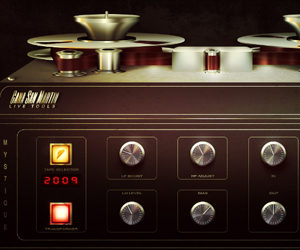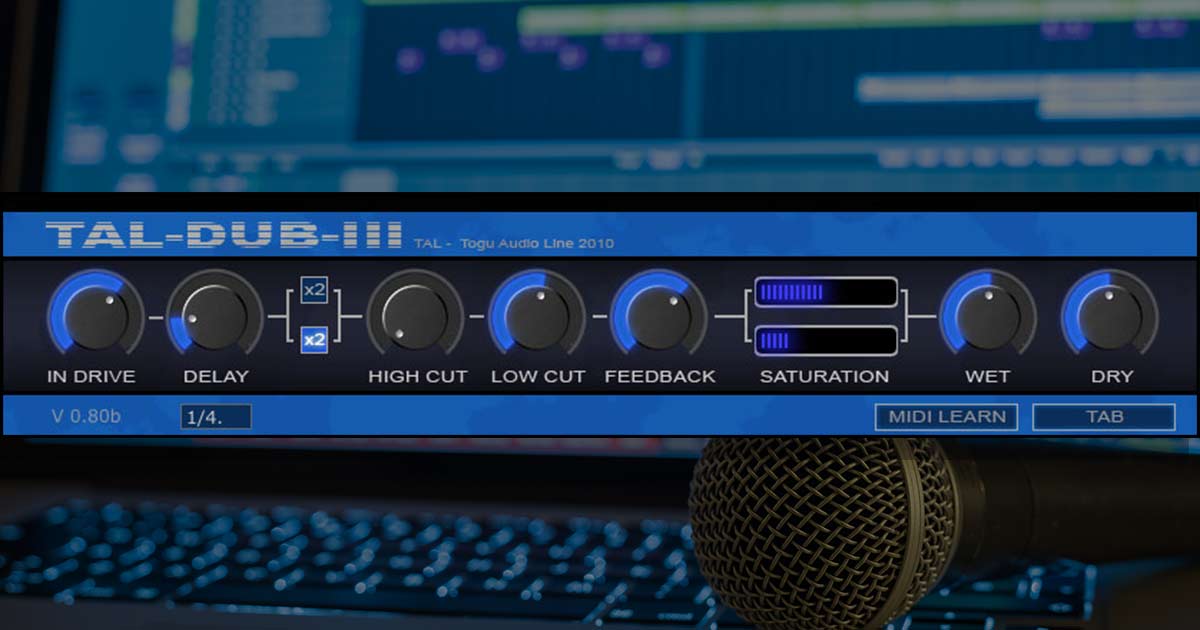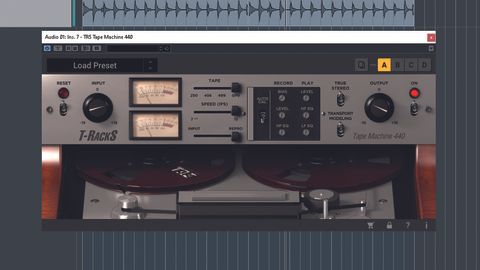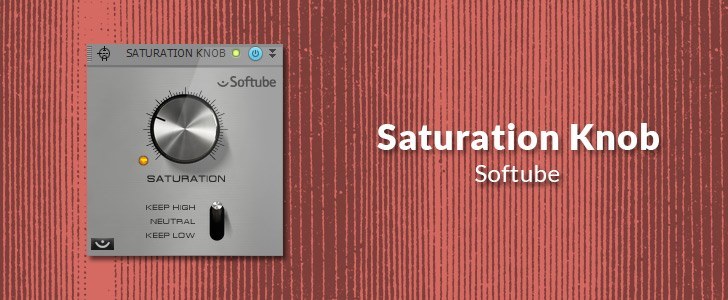What Is Audio Saturation?May 10, 2012
- BPB Saturator is a freeware saturation effect that is lightweight and easy to operate. It utilizes waveshaping to simulate tube and tape saturation. The plugin can work as a subtle saturation tool or a tube-based distortion effect. The tube and tape saturation ddmodules can be used separately. It is also possible to apply both types of.
- Another great plugin, the Satin plugin by u-he models the different components of a tape machine, rather than the machine as a single unit, and emulates their interaction between one another to produce the desired distortion. The key feature of this saturation plugin is its flexibility, as it gives you the ability to select the parts of the.
Are you ready to start using analog-like warm plugins in your studio? Maybe you are already using saturation plugins but are just not sure what audio saturation is. Either way this week's article is for you.
Well surely you have heard the term “saturation” before. It is used by many companies to describe their plugins but what does the term really mean? What Is Audio Saturation? Do you really need to have saturation plugins in your studio toolbox? What are the differences between tube and tape saturation? What is all the hype over analog-like plugins really about? This week we talk saturation plugins and see if we can answer some of these questions and more.
The free plug-in Saturation Knob is a modeled output distortion that can be used anywhere you need some grit. Use it to fatten up bass lines, add some harmonics and shimmer to vocals, or simply destroy your drum loop.
We will cover the following:
- What is saturation?
- What is the hype with saturation plugins really about?
- What is the difference between tube and tape saturation?
- Where do you use saturation?
- Do you really need to add saturation plugins to your production toolbox?
WHAT IS SATURATION?
As more and more processes in audio production are done digitally it seems the goal is to sound more analog-like and less...well...digital. Huh? Is that right? Yes, that is right. As we as producers and engineers become less dependent on the use of hardware the goal is to sound as if you are still heavily dependent on it. You may be working in the box, but you sure don't want to sound like it if you listen to the plugin companies. The direction of most audio plugin makers over the last two or three years have been for their plugins to sound more like their analog forefathers and less like their truth selves, which are made from “0's” and “1's”.
As engineers and producers move away from working only on large consoles to doing a greater amount of their work digitally, manufacturers try to fill the need for “warmth” with a wide array of plugin choices. Some are quite remarkable and some are quite remarkably poor and others are nothing more than clever marketing period. So rather you think analog hardware is sacred and should not be emulated or rather you just see it as a natural transition that plugin manufacturers must make, the reality is that companies have decided to go this route some years back and all the major companies are on board.
So what is saturation as it relates to audio?
When we talk about “analog warmth” and “saturation” we really begin to enter very subjective waters. Something that is “warm” sounding to one person may not be to another. That being said lets look at the terms basic definition instead for a better idea of the true meaning of saturation.
The term saturation gets it's origins from the amount of magnetism a magnetic tape could hold. See in the days before digital engineers recorded everything to tape. When recording to tape you could get distortion from the tape's oxide particles by adding more magnetism (magnetism is a force of attraction that works within a magnetic field and attracts like materials to it). When recording with the gear of that day (tape, tubes, transistors, etc.) you could easily overload them by the levels being too much. Too much meaning that every device had a magnetic capacity limit. When the magnetic particles no longer responded linearly they had reached their limit. This in turn added or changed the sound by adding color or character to it. When that limit was reached or overloaded this color or character is what you could call saturation. Some saturation, some distortion and now you got yourself some good ole added harmonics right there!
If you enter into just about every audio forum on the internet you are sure to find at least one post about “analog warmth” and it's uses as well as it's practicality. Many of these post end up in very heated (pun intended) discussions about saturation plugins and the use of the phrase “analog warmth”. Many will say that the term “analog warmth” is nothing more than marketing hocus-pocus to get you to buy a companies latest and greatest new “warm” plugin. I know it is hard to believe that a company would not be 100% honest when marketing a product. I felt the same way when I found out most bottled water companies get their water from municipal sources (like the same facets you and I use). Sorry I digress. Anyway, I have decided to leave my personal opinions on “analog warmth” out of this article. I think if you are interested in buying saturation plugins for your project or commercial studio that you grab a few demos and take a listen for yourself. Only your ears and your ears alone will tell you what is best for you and your needs. Not the opinions of other people.
WHAT IS ALL THE HYPE ABOUT?
Get your analog plugins here! Do you see the flashing neon sign yet? Well if you have been around the internet on any music site within the last two or three years then you have surely ran across an ad or two offering the latest plugin promising to give you that “true analog-like sound”. Okay maybe not in neon but you know what I mean. So is this true or truly marketing hype? Well like I said already I won't let my opinions influence your decision on rather or not most of the recent saturation plugin ads are fact or fiction, but I will encourage you to do some fact finding of your own to decide. If you really want to know if these companies can give you a true analog sound from their plugins you will need to take a closer look at the following area;
Understanding Harmonic Distortion
How Gain Staging Works
How Distortion Create
How Real Values & Tubes Work
How Transistors and Transformers Distort
How Were The Emulations Done
Now I will not go into each of the above because it is beyond the scope of this tutorial. Also because this article is not about rather saturation plugins are what they promise to be, but it is written more in the vein of these are some of the facts about saturation plugins and you can make your own final decisions on the subject.
WHATS THE DIFFERENCE BETWEEN TUBE AND TAPE SATURATION?
The two main types of saturation plugins that are out on the market today are tube and tape. There are other types such as transistor, but these two seem to offer the most choices by many different companies. So what really are the differences between the two you might be asking. Well let's take a look.
In basic terms a tube saturation plugin is emulating the sound of a piece of audio that is being passed through some tube hardware. A tape saturation plugin is designed to emulate the sound of a piece of audio that is being ran through tape hardware. Both will introduce distortion to your sound. The type and amount of distortion would be determined by the type of plugin and of course the settings of the user.
Now typically a tape saturation plugin will add a low level distortion to the signal. This is great for things like kicks and snares where you are looking to give the sound some punch. But let's say that you are unsure of the type of sounds that you might use a saturation plugin on then you may opt for one with more options. If this is the case then Mellowmouse's SATV is the way to go. This happens to be a favorite plugin of mine when it comes to analog sounding. With SATV you get four algorithms to choose from (Transistors, Transformers, Tubes and Tape ). With the so many options to choose from you may be tempted to use this little gem on everything, but don't do it. Keep in mind that a little distortion and character in just the right places will surely bring your mix out of the dark!
In my opinion SATV is not the greatest on a main buss or in a mastering situation (PSP's Vintage Warmer may be a better choice there), however on an instrument buss or on a track by itself it really shines.
WHERE DO YOU USE SATURATION?
Drums – I find that adding saturation to drum sounds can really add some needed character at times. Depending on the track there are times that digital drums sound too clean. In these cases it is great to be able to go back in and add some grittiness to them. (I really like using URS' Saturation plugin on drums)
Vocals – Vocals are a tricky one when it comes to saturation. This is where if too much is applied it is very easily heard and could have disastrous results. It will take some practice and some good listening skills to make the best use of saturation on your vocal, but it is well worth it when you get it right. (Love Bootsy's Ferric TDS on vocals! It just somehow makes them sound bigger than life. Great plugin and it is free.) Check out the LINKto get yours.
Mid warmth – Pretty hard to find something better for handling the mids than an API in my opinion. The API is such a legendary and musical EQ that introductions are not needed. Just about every studio that I have ever worked in had at least one emulation of a API. Some controlled distortion to the mid frequencies is a great way to get your mixes to pop. In these cases the API 550 is the first thing that I reach for. It is hard to put into words but it just does something musical to the mid frequencies that make you want to do “the dance of joy” all over your studio (The dance of joy was from a television show when I kid. Not sure why I remembered that).

DO YOU NEED TO ADD SATURATION PLUGINS TO YOUR TOOLBOX?
Free Tape Saturation Plugin Mac Os
That is a good question in which I think the simple answer is it depends on your needs. Notice I did not say that it depends on you. You can always find a way to justify yet another plugin to add to the ole toolbox, but the question is “do you really need it”? Well if you find that you mixes are too clean then you may want to add some saturation to them. However if you are thinking about buying a saturation plugin because you got an email telling you about a big sale. Or you are looking to add a saturation plugin to your arsenal because you read about a new plugin on a form or a website, then these may not be the best reasons for making your purchase. My advice would be to grab some demos or better yet try out the many, many great FREE saturation plugins that are out there. Here are a few that you might want to try out;
If you are using a PC and a DAW that accepts VST plugins then you should head over to Booty's website and try out some of his freebies. I would recommend you check out Ferric TDS, Tessla SE and BootEQ MKII. All very nice plugins that you would not think were free. Great sounding, great GUI, who could ask for anything more. I personally love his stuff. As a matter of fact there are plugins of his that work much better than plugins I paid money for and did I mention they are free?
If you are running on a Mac a very good free tape saturation plugin to try is a plugin called 1-Time. There is also Voxengo's Tube Amp which runs on Windows (both 32 and 64 bit) and Mac's also. My favorite freebie analog-like plugin for the Mac would have to be Sonimus' SonEQ. This thing just works there is no question about it. The GUI is well laid out and easy on the eyes. Everything that is going on behind that interface is right on point. Simply amazing! Oh, and Windows users no need to shed a tear because this plugin is available for Windows 32 bit (sorry doesn't look like there is a 64 bit version as of this writing but hey we can't have it all). Check out the link HERE. This plugin is so good that it will make you want to pay for it. Good thing they have a Donate button on their site.
CONCLUSION
So in conclusion I will ask the same question I began with “Are you ready to start using analog-like warm plugins in your studio? Well of course that is totally up to you but you should be a little more informed now as to the correct answer to that question for yourself. Really the best way to answer that question is to try some different plugins out. One of the most common ways to use a saturation plugin is to throw it on your master buss. The right plugin can give your whole mix an analog feel and take away that sterile sound that you can get with some digital mixes. Stay away from the marketing hype and remember that just because a plugin does not emulate the exact way that the original hardware did does not mean that it can't bring a great end result to your songs. There are no rules so just have fun!
Stay tuned for more weekly tips and tutorials every Wednesday.
Article written by Alex Butler
Alex is an audio engineer, studio producer and freelance writer based out of Seattle, WA.
Lots of people are obsessed with the ‘warmth’ of analog studio gear. Sure—it sounds fuller, more human, more present.

But these days, modeling technology has become really good at simulating the effects of analog circuitry. Our computers and DAW apps are powerful enough to handle these VST workhorses.
So forget about spending tons of money on analog gear.
Here’s 7 VSTs (for both PC and Mac) that will give you that sweet analog warmth.
- SGA1566 Tube Preamp
- TDR Slick EQ
- Ace Amp
- Molot Compressor
- Voxengo Tube Amp
- MJUC jr. Compressor
- Softube Saturation Knob
What’s all the analog fuss about?

Ok, so what does analog circuitry do to your sound? What’s everyone so obsessed about?
What people like about analog sound are the quirks and imperfections.
So when people talk about ‘warm analog sound’ they’re referring to:

- Subtle distortion and drive
- Harmonic distortion
- Tape Saturation
- Vacuum tubes
- Preamps
What these processes do to your sound is often hardly noticeable. That’s what the magic’s about—you won’t hear them, but they’ll make a huge difference in how your track sounds and feels.
The cumulative effect of analog processes is what people are gushing about.
1. SGA1566 Tube Preamp
Shattered Glass Audio’s SGA 1566 gives you a single channel vintage tube preamp. The whole circuit is simulated in real time to get you that authentic analog sound.
Use the SGA 1566 as a saturation compressor to boost the warmth of your track. Or add a bit of grit with the tube overdrive.
The newest version is also lighter on your CPU––so no computer freak outs!!
Download the SGA 1566 for free here.
2. TDR Slick EQ
“This little guy sounds amazing” –Dave Pensado
The TDR Slick EQ is a sleek easy-to-use three-band EQ that gives you amazing sound—like all Tokyo Dawn Records plugins.
Warm up your sound by choosing a non-linear option under Output Stage. That’ll add subtle harmonic distortion and texture.
Download the TDR SlickEQ for free here.
3. Ace Amp
Ace Amp—another Shattered Glass Audio creation—is based on classic 1950s style tube amps.
Control the input, volume, feedback, output. Choose between three resampling options.
This amp plugin has simple controls and doesn’t eat up your CPU.
Hot Tip: Try it on vocals for a cool aesthetic effect.
Download the Ace for free here.
4. Molot Compressor
Vladg’s Molot is a compressor with character. Even the vintage Soviet look is on point.
Molot will give your sound interesting color. I recommend reading the manual to learn how to tune it properly—it’s worth the read.

Download Molot for free here.
5. Voxengo Tube Amp
Voxengo’s Tube Amp gives you warm overdrive, fuzzy distortion and everything in between.
It imitates tube overdrive in the style of single-tube mic preamps.
Free Tape Saturation Vst
Hot Tip: Use the low-pass filter to imitate the texture of lower-quality tubes.
Download Voxengo’s Tube Amp for free here.
6. MJUC jr. Compressor
Klanghelm’s MJUC jr. compressor is simple and elegant.
Use it for smooth compression or a heavier pumping effect. MJUC jr. is based on vintage compressors of the 1960s––it even looks like one.
Flip the ‘Time Constants’ switch to choose between slow, fast and auto. This changes the attack and release time. It affects other parts of the circuitry too, giving you interesting analog-style saturation.
Download the MJUC jr. for free here.
Saturation Vst Free
7. Softube Saturation Knob
Best Tape Saturation Plugin
This Saturation Knob is one the best free analog emulation plugins out there. Even Dave Pensado gives it two thumbs up!
Use it anywhere to add some character and distortion. Drag it on your vocal track to add shimmer.
The great thing about this one is how simple it is: literally one knob and a switch. Change the switch setting to choose between the kind of distortion you’ll get.
Download the Softube Saturation Knob for free here.
Free Tape Saturation Plugin Mac
Fake It Till Ya Make It
These effects are the missing ingredient in your digital sound.
The key with analog emulation is to avoid overdoing it. Bring in the effect until you hear it, then dial it back a notch. It’ll still make a huge difference. Your sound will be fuller and warmer.
Use these plugins and people will be asking for your studio secrets in no time.
Make sure to grab the whole LANDR-approved free VST plugin collection: